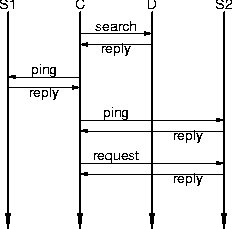NLRS systems comprise two different client-server subsystems, called the the Directory and Supplier subsystems. A Supplier subsystem is responsible for providing files to clients; the Directory subsystem is responsible for keeping track of the available Supplier subsystems. A complete NLRS system comprises one Directory and zero or more Suppliers (a system with zero Suppliers won't be able to do much, but it's still a valid configuration).
Client interaction with a NLRS system is has three phases, of which the middle one is optional. Suppose client program C is looking for a particular resource (a file, say) and wants to use a NLRS system N to find the file. C performs the following:
- Send a search request to N's Directory and receive a reply listing, for each resource R requested, the Suppliers (if any) that can provide R.
- Send a ping request to each Supplier S to determine if resource R is available from S. The reply from S not only indicates R's availability, but also some indication of the load on S at the time it handled the ping request.
- Based on the ping replies, client C selects one or more of the Suppliers that can provide resource R and sends a resource request to the selected Suppliers.
For example, the event diagram

shows a client C searching for some resource and receiving from D the reply that Suppliers S1 and S2 have the resource. C pings both suppliers and decides that S2 is faster, and makes its resource request to S2.
The Directory D and Suppliers in a NLRS system N also interact: